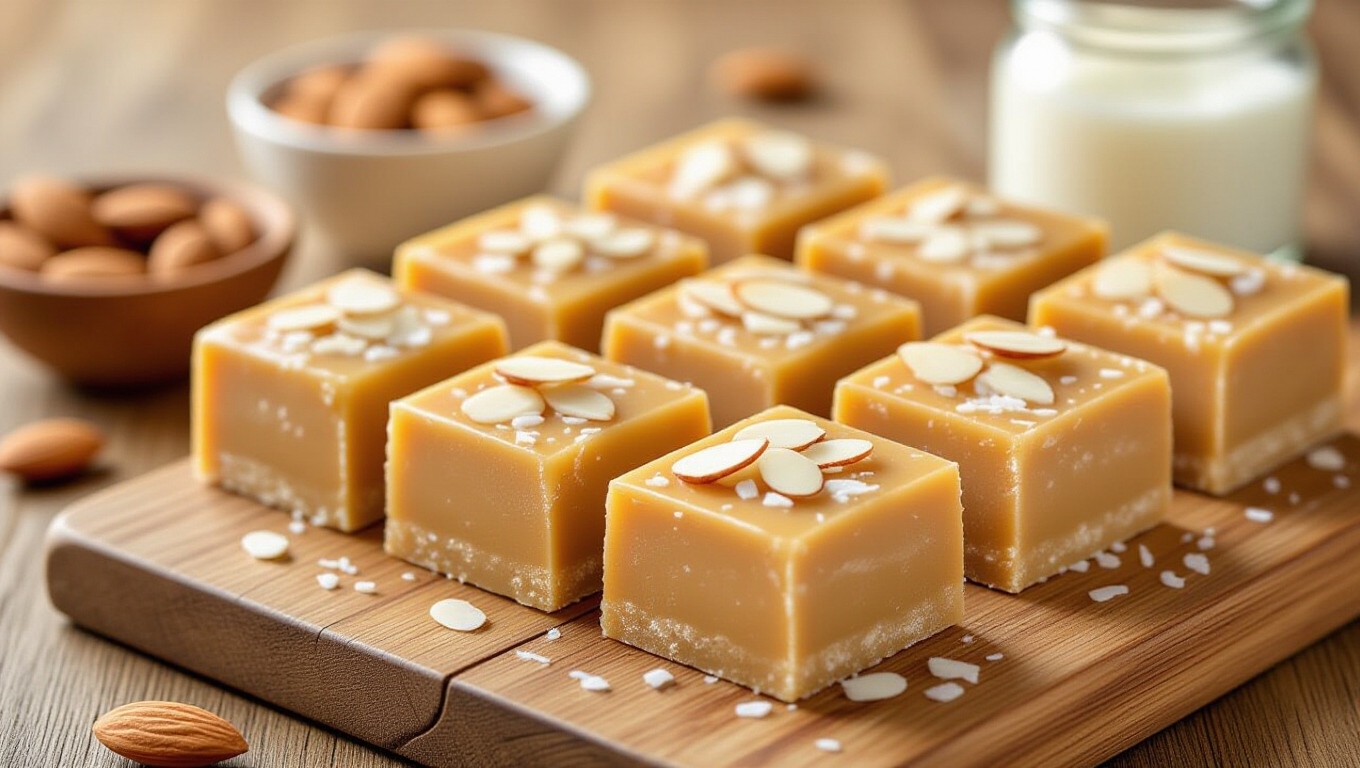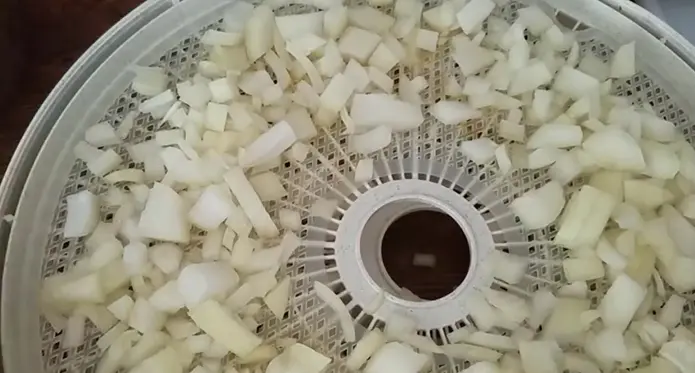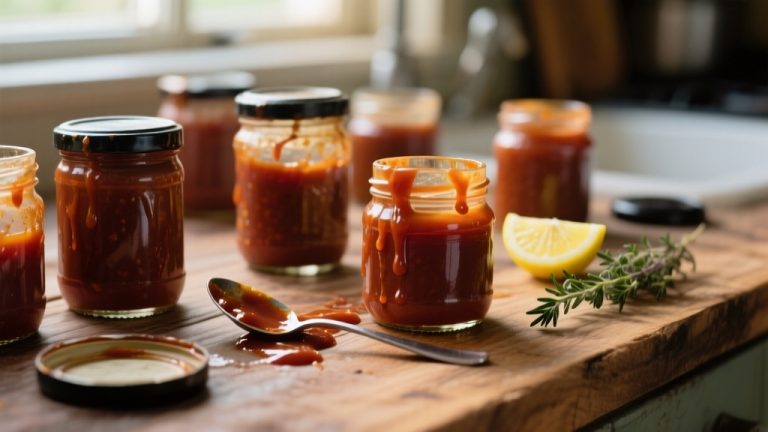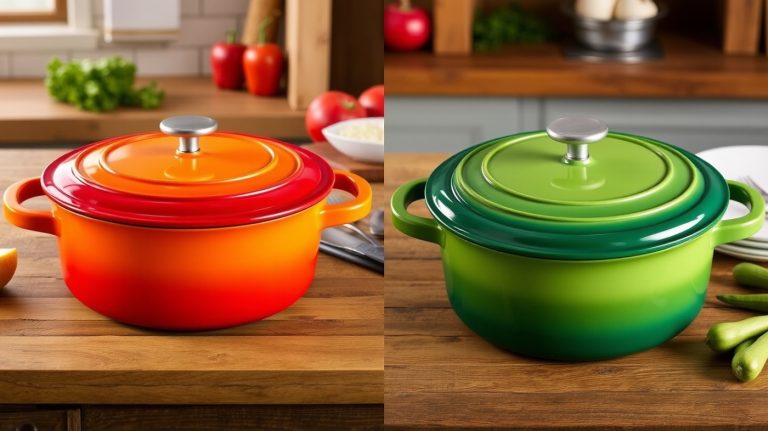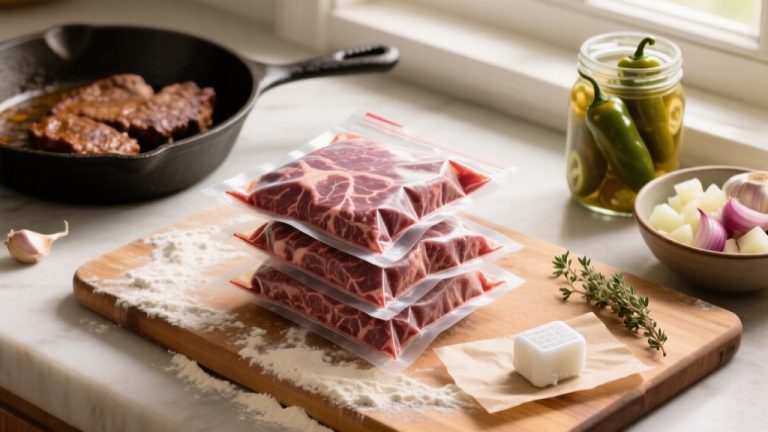Sugar Free Candy Recipe: Easy, Tasty and Guilt-Free Treats
You’ll want to start by choosing sweeteners like erythritol or stevia for sweetness and maltitol or polydextrose to mimic sugar’s bulk and texture. Incorporate hydrocolloids such as gelatin to prevent crystallization and control chewiness.
Use a candy thermometer to monitor exact temperatures, ensuring clarity and hardness without sugar. Balance flavors carefully with acidulants to preserve freshness while managing aftertastes and digestive effects.
Following precise ingredient ratios and process steps leads to successful sugar-free candy. Exploring each component further reveals deeper craft nuances.
Key Takeaways
- Use sugar substitutes like sucralose and erythritol for sweetness and bulk without raising blood sugar levels.
- Incorporate hydrocolloids like gelatin or pectin to enhance candy texture and prevent crystallization.
- Monitor cooking temperature precisely with a candy thermometer for ideal candy hardness and clarity.
- Add flavorings and acidulants carefully to balance taste and preserve freshness without sugar.
- Use food-grade silicone molds and heatproof utensils to ensure safe and consistent candy shaping.
At-a-Glance Candy Making Table: Steps and Ingredients
| Ingredient / Tool | Quantity | How to Use / Step & Purpose |
|---|---|---|
| Maltitol or Isomalt | 2 cups | Dissolve in water over medium heat to form a clear syrup. This provides the bulk and sweetness that replaces sugar. |
| Erythritol or Stevia | To taste | Add gradually to the syrup to adjust sweetness. This enhances flavor without raising blood sugar. |
| Gelatin or Pectin | 1–2 tbsp | Sprinkle and dissolve into the syrup to create structure. This ensures chewiness and firmness in the candy. |
| Citric Acid | 1 tsp | Stir in toward the end of cooking to balance sweetness. Adds tartness and preserves flavor freshness. |
| Natural/Artificial Flavoring | 1–2 tsp | Add at ~80°C to maintain aroma. Enhances taste and masks any sweetener aftertaste. |
| Unsalted Butter | 2 tbsp (optional) | Mix in for richness. Improves texture and adds smoothness. |
| Filtered Water | ½ cup | Use as base to dissolve sweeteners. Ensures even heat distribution during cooking. |
| Candy Thermometer | 1 unit | Monitor syrup temperature carefully. Guarantees candy reaches the correct hardness and clarity. |
| Silicone Candy Molds | As needed | Pour cooked candy into molds to shape and cool. Ensures uniform size and form of candies. |
| Heatproof Spatula/Spoon | 1 unit | Stir ingredients safely while cooking. Prevents burning and allows even mixing. |
Choosing the Right Sugar Substitutes
When selecting sugar substitutes for sugar-free candy, you must carefully balance sweetness intensity, heat stability, texture, and aftertaste to achieve the desired sensory and functional properties.
Artificial sweeteners like sucralose offer high sweetness with excellent heat stability, while aspartame’s heat sensitivity limits its use in cooked candies.
Sucralose provides intense sweetness and heat stability, unlike aspartame which is unsuitable for cooked candies.
Sweeteners such as maltitol and erythritol provide bulk and texture similar to sugar, with erythritol also imparting a cooling mouthfeel. These are popular in sugar-free products due to their low-calorie content.
Natural sweeteners like stevia and monk fruit deliver intense sweetness but may contribute bitter or licorice-like aftertastes depending on purity. You’ll often blend sweeteners to optimize sweetness profile and minimize aftertaste.
Additionally, consider the functional roles: these sweeteners maintain volume and mouthfeel, while heat-stable options withstand cooking temperatures, ensuring consistent candy quality.
Essential Ingredients for Sugar-Free Candy
When crafting sugar-free candy, you’ll rely on specific sugar substitutes that replicate sweetness without spiking blood sugar.
Texture enhancers like sugar-free syrups and fat sources play a critical role in preventing crystallization and achieving the desired mouthfeel.
Additionally, precise use of flavorings and acidulants balances taste and preserves freshness, ensuring the final product meets quality standards. Using unsalted butter as a fat source adds both flavor and essential fat content to enhance the candy’s texture.
Texture Enhancers Role
Texture enhancers play a vital role in sugar-free candy formulation by compensating for sugar’s structural and sensory contributions.
You’ll rely on hydrocolloids like gelatin, pectin, and agar-agar to regulate firmness and chewiness, tailoring texture through their unique gel-forming properties. These ingredients are critical because they create desired chewiness and firmness that sugar substitutes alone cannot provide.
Fiber-based enhancers such as polydextrose and oligofructose provide bulk and mouthfeel while supporting sugar reduction and nutritional value.
Incorporating polyols like erythritol and xylitol not only mimics sweetness but also influences density and crystallization, essential for replicating traditional candy textures. Protein and plant-based gels offer chewiness alternatives that suit vegan preferences.
Additionally, syrups derived from tapioca, agave, and maltose adjust viscosity and moisture retention, preventing crystallization and enhancing softness.
Flavoring and Acidulants
Beyond managing texture, sugar-free candy formulation demands careful attention to flavorings and acidulants to replicate traditional taste profiles without sugar.
You’ll use natural and artificial flavorings to mask sweetener aftertastes and enhance sensory appeal. Sugar-free flavor powders are developed to sweeten beverages and confections naturally, providing flavor without calories.
Acidulants like citric, malic, and tartaric acids provide tartness, balance sweetness, and stabilize the product. Precise ratios optimize the flavor-acidulant synergy to mimic classic candy varieties accurately.
- Natural and artificial flavor powders customize candy taste without calories
- Citric acid imparts sharp tartness and balances sweetness
- Malic acid extends sourness duration and enhances fruit notes
- Acidulants lower pH, preserving shelf life and preventing microbial growth
- Controlled acidulant levels prevent irritation and mask sweetener bitterness
Flavoring Techniques for Sugar-Free Candy
Although sugar-free candies eliminate traditional sugars, achieving appealing and balanced flavors requires employing specialized flavoring techniques. You should combine natural sweeteners like stevia or erythritol with sugar-free flavor powders, adding them gradually to prevent clumping and guarantee uniform taste.
Incorporate heat-stable powders during cooking, and add heat-sensitive flavorings post-cooking to preserve aroma. Using electrolytes or controlled salt enhances sweetness perception without sugar. Experiment with layering flavors and balance sweetness with sour powders for complexity.
Additionally, selecting sweeteners such as stevia and erythritol helps maintain stable blood sugar levels, reducing health risks associated with sugar consumption.
| Technique | Purpose |
|---|---|
| Gradual powder incorporation | Prevents clumping, guarantees even flavor |
| Heat-stable vs. heat-sensitive powders | Maintains flavor integrity during cooking |
| Electrolyte/salt addition | Enhances sweetness perception and balance |
Achieving Perfect Texture and Consistency
Achieving perfect texture and consistency in sugar-free candy demands precise control over hydrocolloids, sweeteners, and processing conditions. You must balance gelling agents like gelatin or pectin with polyol sweeteners such as maltitol to replicate traditional candy textures without sugar.
Modified starches and cellulose derivatives are critical for stabilizing viscosity and preventing syneresis, but their concentrations require careful calibration to avoid density or stickiness issues. Temperature control during cooking and setting phases influences gel formation and firmness, while cooling rates affect crystallization and texture uniformity.
Combining opposite textures creates exciting contrasts and can elevate the sensory experience of sugar-free candies by adding contrast that mimics sugar-based treats.
Consider these factors closely:
Pay close attention to ingredient balance and process control for ideal sugar-free candy texture and consistency.
- Optimize hydrocolloid types and concentrations for desired chewiness or firmness
- Balance polyol sweeteners to maintain moisture and mouthfeel
- Use modified starches to enhance texture stability without over-thickening
- Control thermal parameters precisely during cooking and cooling
- Combine textures strategically for multisensory appeal in sugar-free confections
Necessary Equipment for Candy Making
You’ll need an essential candy thermometer to monitor precise temperatures critical for sugar-free candy textures. Using heatproof utensils like stainless steel spoons with insulated handles guarantees safe, efficient stirring without material degradation.
Silicone molds offer flexibility and non-stick benefits, improving candy release and maintaining shape integrity during cooling. Additionally, incorporating a batch cooker can enhance small test production runs for sugar-free candies, ensuring consistent quality and control.
Essential Candy Thermometer
One significant tool for successful candy making is the candy thermometer, which guarantees precise temperature control fundamental for achieving specific candy stages. Temperature during cooking is crucial for candy quality and directly affects texture and final result, emphasizing the importance of accurate measurement.
Accuracy within ±1–2°F is essential, as even minor deviations affect textures like “Firm Ball” or “Soft Crack.” Digital models, such as the Thermapen ONE, deliver superior precision (±0.5°F) and rapid response, reducing error risk.
When choosing your thermometer, consider these important features:
- Long probe (approximately 8 inches) for accurate readings and user safety
- Pot clip for stable, hands-free monitoring
- High temperature range (up to 400°F+) for diverse candy stages
- Programmable presets and alarms to signal target temperatures
- Durable digital sensors resistant to thermal shock with minimal recalibration
Employing such a thermometer guarantees reproducibility and prevents under- or overcooking, essential for consistent sugar-free candy results. Using a candy thermometer and guide assists in maintaining sugar concentration and distinguishing between success and failure in candy making.
Silicone Mold Benefits
Silicone molds provide critical advantages in candy making, combining flexibility with a broad range of shapes that enhance design possibilities and simplify candy release. Their flexibility allows you to unmold detailed gummies and hard candies without damage, preserving intricate shapes better than rigid metal molds.
Silicone’s heat resistance up to 260°F suits heated candy processes, while its low thermal conductivity slows cooling, affecting setting time. Silicone molds are flexible, long-lasting, and easy to use for various applications. Additionally, these molds are often compatible with food-grade silicone sheets, ensuring safe contact with your candy.
You’ll appreciate the inherent non-stick surface, which reduces the need for greasing and facilitates easy cleanup—silicone molds are dishwasher safe and durable. Food-grade silicone guarantees chemical safety, free from BPA or phthalates, maintaining candy purity.
Heatproof Utensil Types
Because precise temperature control and safe handling are critical in candy making, selecting appropriate heatproof utensils is vital. You need tools that resist heat without warping or conducting excessive heat to prevent burns and maintain control.
Opt for materials engineered to withstand temperatures reaching 400°F (204°C) without degradation. Consider these essentials for your candy-making toolkit:
- Silicone spatulas with heat resistance for safe stirring and scraping
- Stainless steel spoons offering durability and minimal heat conduction
- Long-handled utensils to protect your hands from hot syrup exposure
- Heavy-bottomed stainless steel pots for even heat distribution
- Candy thermometers (digital preferred) with clip attachments for precise temperature monitoring
Having necessary tools makes the candy-making process more enjoyable and helps achieve faster, accurate results. Using these heatproof utensils guarantees safety, accuracy, and consistency throughout your sugar-free candy preparation.
Step-by-Step Sugar-Free Candy Preparation
Preparing sugar-free hard candy involves a series of precise steps where ingredient ratios, temperature controls, and timing are critical. First, dissolve maltitol and isomalt in water to form a clear syrup, avoiding graininess. This process often utilizes natural or low-calorie sweeteners to replace traditional sugar while preserving the candy’s sweetness.
Next, cook the syrup under controlled temperature (170–230 ℃) and steam pressure, then apply vacuum concentration to reduce moisture below 2%. Afterward, incorporate flavorings and additives at ideal temperatures to guarantee uniform distribution and mask polyol aftertaste. Finally, cool the candy mass to solidify.
| Step | Temperature (℃) | Time |
|---|---|---|
| Dissolve & Mix | Room Temp | Until fully dissolved |
| Cook & Concentrate | 170–230 | 30–120 minutes |
| Flavor & Cool | ~80 | Add flavors, then cool |
Frequently Asked Questions
Can Sugar-Free Candy Be Stored Long-Term Without Refrigeration?
You can store sugar-free candy long-term without refrigeration if you keep it in a cool, dry environment between 65-75°F (18-24°C).
Use airtight containers to prevent moisture and air exposure, which degrade texture and flavor. Avoid heat, sunlight, and humidity to minimize spoilage risks.
While refrigeration often causes condensation damage, properly sealed sugar-free hard candies can last up to a year or more at room temperature without quality loss.
How Do Sugar-Free Candies Affect Dental Health Compared to Regular Candy?
You’ll find sugar-free candies generally reduce tooth decay risk since they lack fermentable sugars that feed acid-producing bacteria.
Many contain xylitol, which inhibits plaque-forming bacteria and stimulates saliva, aiding oral cleansing.
However, acidic ingredients or sticky textures in some sugar-free options can still erode enamel or promote plaque.
Compared to regular candy, sugar-free varieties offer dental benefits but require mindful consumption and good hygiene to avoid enamel damage.
Are Sugar-Free Candies Safe for Children and Pregnant Women?
Oh sure, give toddlers glycerol-laced treats and watch hypoglycemia party!
In reality, sugar-free candies contain substitutes like glycerol, posing toxic risks to children under four, including drowsiness and metabolic imbalances.
The AAP advises strict limits for kids and caution during pregnancy due to unknown long-term effects.
You should consult healthcare providers, as these candies offer no nutrients and may disrupt appetite regulation, making them a risky choice for children and expecting mothers.
What Are the Best Packaging Options for Homemade Sugar-Free Candy?
You’ll want airtight containers made from BPA-free plastic or glass to prevent moisture and preserve freshness, especially for gummies.
Individual wrapping with food-grade cellophane or wax paper helps avoid sticking and cross-contamination.
Silicone molds guarantee uniform shape during production, while trays keep candies separated post-molding.
Clear labeling of ingredients and sugar-free status is essential.
Prioritize recyclable or biodegradable materials to meet environmental and health standards effectively.
Can Sugar-Free Candy Recipes Be Adapted for Vegan Diets?
Imagine crafting candy like a chemist—each ingredient precisely swapped to maintain structure and taste.
You can adapt sugar-free candy recipes for vegan diets by replacing gelatin with agar-agar and refined sugars with natural sweeteners like maple syrup.
Use plant-based creams for richness and vegan chocolate for coating.
This method guarantees texture and flavor integrity while aligning with vegan principles, demonstrating that with analytical adjustments, you can achieve both health and ethical goals successfully.
Experiment, Taste and Perfect Your Candy Creations
As you craft sugar-free candy, imagine each ingredient as a precise gear in a finely tuned machine. By selecting the right substitutes and mastering texture, you transform simple components into a balanced, health-conscious treat.
This process demands careful measurement and attention to detail, ensuring flavor and consistency align perfectly. Your technical skill turns raw elements into a satisfying confection, proving that science and creativity combine seamlessly in every bite.

